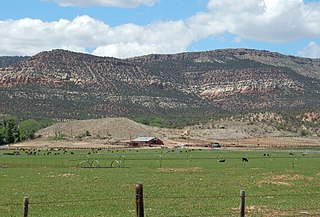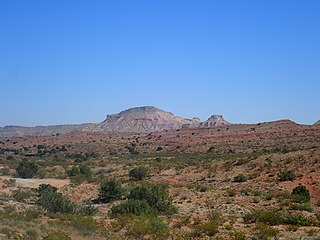
The Permian Basin is a large sedimentary basin in the southwestern part of the United States. The basin contains the Mid-Continent Oil Field province. This sedimentary basin is located in western Texas and southeastern New Mexico. It reaches from just south of Lubbock, past Midland and Odessa, south nearly to the Rio Grande River in southern West Central Texas, and extending westward into the southeastern part of New Mexico. It is so named because it has one of the world's thickest deposits of rocks from the Permian geologic period. The greater Permian Basin comprises several component basins; of these, the Midland Basin is the largest, Delaware Basin is the second largest, and Marfa Basin is the smallest. The Permian Basin covers more than 86,000 square miles (220,000 km2), and extends across an area approximately 250 miles (400 km) wide and 300 miles (480 km) long.

The Delaware Basin is a geologic depositional and structural basin in West Texas and southern New Mexico, famous for holding large oil fields and for a fossilized reef exposed at the surface. Guadalupe Mountains National Park and Carlsbad Caverns National Park protect part of the basin. It is part of the larger Permian Basin, itself contained within the Mid-Continent oil province.
Caprock or cap rock is a harder or more resistant rock type overlying a weaker or less resistant rock type. Common types of caprock are sandstone and mafic rock types. An analogy of caprock could be the outer crust on a cake that is a bit harder than the underlying layer. Common caprock locations are escarpments, mesa formations, and salt domes. In the petroleum industry, caprock is generalized to any nonpermeable formation that may prevent oil, gas, or water from migrating to the surface.

In geology, the Paradox Formation Is a Pennsylvanian age formation which consists of abundant evaporites with lesser interbedded shale, sandstone, and limestone. The evaporites are largely composed of gypsum, anhydrite, and halite. The formation is found mostly in the subsurface, but there are scattered exposures in anticlines in eastern Utah and western Colorado. These surface exposures occur in the Black Mesa, San Juan and Paradox Basins and the formation is found in the subsurface in southwestern Colorado, southeastern Utah, northeastern Arizona and northeastern New Mexico.

The Cherry Canyon Formation is a geologic formation found in the Delaware Basin of southeastern New Mexico and western Texas. It contains fossils characteristic of the Guadalupian Age of the Permian Period.

The Bell Canyon Formation is a geologic formation found in the Delaware Basin of southeastern New Mexico and western Texas. It contains fossils characteristic of the Guadalupian Age of the Permian Period.

The Bone Spring Formation is a geologic formation found in the Delaware Basin in Texas and New Mexico. It preserves fossils dating back to the Leonardian Age of the Permian Period.

The Capitan Formation is a geologic formation found in western Texas and southeastern New Mexico. It is a fossilized reef dating to the Guadalupian Age of the Permian period.

The Hueco Formation is a geologic formation in west Texas and southern New Mexico. It preserves fossils dating back to the early Permian period.

The San Andres Formation is a geologic formation found in New Mexico and Texas. It contains fossils characteristic of the late Leonardian (Kungurian) Age) of the Permian Period.

The Seven Rivers Formation is a geologic formation in southeastern New Mexico and west Texas. It preserves fossils dating back to the late Guadalupian Epoch of the Permian period.

The Tansill Formation is a geologic formation in southeastern New Mexico, USA. It preserves fossils dating back to the late Guadalupian Age of the Permian period.

The Yates Formation is a geologic formation in southeast New Mexico and west Texas. It preserves fossils dating back to the late Guadalupian Age of the Permian period.

The Yeso Group is a group of geologic formations in New Mexico. It contains fossils characteristic of the Kungurian Age of the early Permian Period.

The Burro Canyon Formation is an Early Cretaceous Period sedimentary geologic formation, found in western Colorado, the Chama Basin and eastern San Juan Basin of northern New Mexico, and in eastern Utah, US.
Mary Louise Rhodes was a petroleum geologist in the United States. Rhodes was born April 5, 1916 in Clinton, Missouri. She achieved a bachelor’s degree (1938) and a master’s degree (1939) in Geology at the University of Missouri. In 1942, Rhodes started her professional career in the production department at the Standard Oil Company of Texas (SOTEX), where she examined well samples, constructed sample logs, and prepared subservience maps and cross-sections. Later she transferred to the exploration department in 1946, she continued to work in this department for the rest of her career. Her duties in this department mainly included travelling the world to collect soil samples and collect to find oil reserves. Throughout her professional career, Rhodes became well known as a carbonate stratigrapher and an expert on several of the Permian basin rock units. Rhodes died on June 26, 1987 from cancer in Midland, Texas.

The Queen Formation is a geologic formation in southeastern New Mexico and west Texas. It preserves fossils dating back to the late Guadalupian Epoch of the Permian period.

The Victorio Peak Formation is a geologic formation found in the Delaware Basin in Texas and New Mexico. It preserves fossils dating back to the Leonardian Age of the Permian Period.

The Grayburg Formation is a geologic formation in west Texas and southern New Mexico. It preserves fossils dating back to the Guadalupian Epoch of the Permian Period.

The Castile Formation is a geologic formation in west Texas and southeastern New Mexico. It was deposited in the Ochoan Stage of the Permian period.








